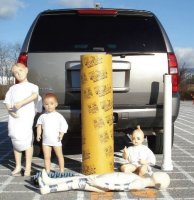
— After years of discussions and delays, the National Highway Traffic Safety Administration (NHTSA) today issued a rule requiring rear-view technology in all new vehicles manufactured on or after May 1, 2018.
NHTSA said the rule applies to all vehicles under 10,000 pounds, which includes everything from the smallest cars to trucks and buses.
The rule requires the driver to see a 10-foot by 20-foot zone directly behind the vehicle. Additional requirements will need to be met including image size, response time, durability, and deactivation of the system.
According to previous research, there are about 210 fatalities and 15,000 injuries per year caused by backover accidents. Children under 5 years old account for 31 percent of backover fatalities each year, and adults 70 years of age and older account for 26 percent.
NHTSA previously said rear-view cameras could prevent between 95 and 112 fatalities per year. However, NHTSA now says the technology is estimated to save 58 to 69 lives per year. Previous estimates put the cost at up to $19 million per life saved.
NHTSA didn't say what caused them to drop their estimates from 95 to 112 lives saved to a lower 58 to 69 lives saved. However, rear-view cameras have been increasingly in use and it's possible NHTSA now realizes the cameras are limited in how much they can help.
As noted in an August, 2012, story from CarComplaints.com, numerous problems can arise from using rear-view cameras and their warnings can easily be ignored.
Rear-View Camera False Alarms
Researchers say that false alarms can make a driver begin to ignore the vision screen.
What are false alarms? In testing, a rear-view camera set off alarms on a garden hose, construction materials, pallets, landscaping timbers, tree stumps, toys, cracks in driveway surface, curbs, guttering, and wood piles.
Some of those objects were to the side of the vehicle, yet the alarm sounded as if the object was directly behind the vehicle.
Another concern is rain, fog, and other kinds of weather that can significantly reduce the ability to show drivers a clear view of objects in the blind zone in back of the vehicle.
Even in clear daytime conditions, objects in the camera display may be difficult to see due to glare from the sun.
As for backover accidents that tragically take place at home, a rear-view camera won’t be the answer to prevent all incidents. In one study of 51 driveway accidents, 19 of the people struck by a backing vehicle came as a result of a child knocking the car out of gear.
"Rear visibility requirements will save lives, and will save many families from the heartache suffered after these tragic incidents occur," said NHTSA Acting Administrator David Friedman. "We're already recommending this kind of life-saving technology through our NCAP program and encouraging consumers to consider it when buying cars today."




